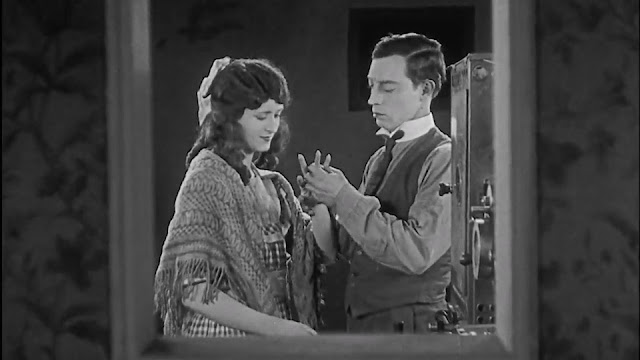Sherlock Jr. (1924)
Buster Keaton’s Sherlock Jr.
Thematic Elements:
Buster Keaton’s “Sherlock Jr.” tells the story of a projectionist who is wrongly accused of theft. The projectionist is in love with the girl, only for the girl’s other pursuer to thieve her father’s watch and blame it on the projectionist. The projectionist tries to use his detective skills to track down the thief and catch him red-handed. However, his plans fail. Dejected, he goes back to projecting films at the cinema. There, he falls asleep and dreams of solving the case and winning back the heart of the girl. He awakens, only to realize that it was just a dream. However, the girl returns and tells him they wrongly accused him.
The story does an excellent job of blending fantasy and reality. The projectionist leaves reality and enters the world of both dream and cinema, two places where anything is possible and he can become anyone. His dreams of becoming a detective are fulfilled in these places. In reality, he gets yelled at by his boss for doing a bad job, he gets framed for a crime he did not commit, and he cannot satisfy the needs of the girl he loves. However, in his dream state, he is able to be the person he wants to be. When he enters his dream state, he walks right up to the projection screen and climbs up and enters it, becoming part of the projected film itself. Keaton is suggesting that the cinema is a place for fantasy, lacking a biting and harsh reality.
Camerawork:
Tracking Shot: Keaton utilizes a great tracking shot when Sherlock Jr. is riding on a driverless motorcycle. As he rides over train tracks and city streets, he covers his face to avoid looking at oncoming trains and cars. The use of this tracking shot by Keaton is for comedic effect. As he rides the bike, the camera tracks with it, showing the viewer the incredibly close calls that Sherlock Jr. has by almost getting hit.
Superimposed Image: To give the indication that the projectionist has entered a dream state, Keaton overlays a superimposed image of the protagonist as he ‘steps’ away from his body, realizing that he is now ‘ghost-like’ in a dream state. The superimposed image is clearly meant to convey this ‘ghost-like’ state, providing the viewer the context that what they are seeing is not reality – but rather the special effect of dreaming.
Push-In: Keaton uses a push-in after the ghost-like state of the projectionist climbs into the cinema screen. The camera pushes in as the frames of the screen fill up the frames of the screen the viewer is watching. By doing this, Keaton has emphasized that we the viewer have now entered into a separate reality, one in which the character we have come to know by this point is no longer himself, but exists as a fantastical fantasy. The push in to the film screen indicates this transition and indicates to the audience of their new reality.
Best Shot:
Framing: A the very end of the film, Keaton’s projectionist wakes up to realize that what had just happened was all a dream. Then, the girl shows up to tell him that they had wrongly accused him. We see the projectionist and the girl framed by the projection window of the projection booth. This framing resembles the cinema screen that the projectionist is watching. This framing indicates to the viewer that the reality that the projectionist has woken up to may as well be as fantastical as the film screen. The ending itself perhaps calls into questions the notion of what is real any longer. Even though we are told that the projectionist has woken up, we the viewer still realize we are watching a film. Keaton indicates this with the framing of the two in what looks like a cinema screen – reminding us that fantasy and reality and becoming merged.




Comments
Post a Comment